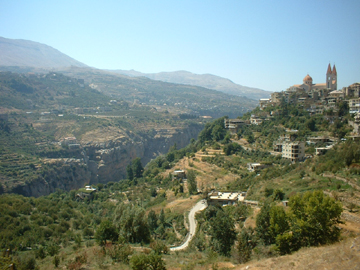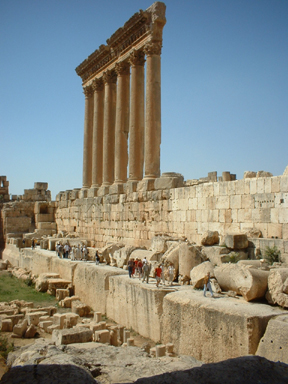Geotimes

Untitled Document

Travels in Geology
December 2004
Lebanon's limestone: Where
the mountains meet the sea
 Sandwiched between
Israel and Syria, Lebanon is a green and white jewel on the Mediterranean Sea.
The green comes from Lebanon's humid and semi-tropical climate along the coast
and the springs flowing down from the mountains. The white is from the limestone
covering most of the country. The white mountains are so dramatic that the country's
name, Lebanon, shares its root with the Semitic word for white. This breathtaking
scenery and geology make Lebanon a great place to visit — where you can
ski at 2,000 meters in the morning and swim in the warm Mediterranean Sea in
the afternoon.
Sandwiched between
Israel and Syria, Lebanon is a green and white jewel on the Mediterranean Sea.
The green comes from Lebanon's humid and semi-tropical climate along the coast
and the springs flowing down from the mountains. The white is from the limestone
covering most of the country. The white mountains are so dramatic that the country's
name, Lebanon, shares its root with the Semitic word for white. This breathtaking
scenery and geology make Lebanon a great place to visit — where you can
ski at 2,000 meters in the morning and swim in the warm Mediterranean Sea in
the afternoon.
Lebanon's tiny size — 10,400 square kilometers — is a boon to the
traveler. The country can be reached by air on several international carriers,
or by land from Syria, and American citizens can get a visa upon arrival for
U.S.$35. Lebanon's reputation as a resort destination collapsed during its 16-year
civil war (which involved surrounding countries including Syria and Israel,
and resulted in the kidnapping of Americans and Europeans in the 1980s by jihad
groups), but the country has made a rapid recovery and now welcomes tourists.
The town of Bcharre
rests on the edge of a cliff, and features a rock-cut monastery owned by writer
Khalil Gibran. In the winter, the area is a popular destination for skiers.
Photos by Kimberly Krieger.
The far corners of the country are accessible as easy day trips from Beirut
or Tripoli by bus or service taxi. Once at a destination, hiking around on foot
is the best way to examine interesting features of the landscape. When you're
ready to go back, just stand on the side of the road and hail a bus going in
your direction — it's how the Lebanese travel, too. Although a few travelers
have bicycled through the country, the mountainous terrain makes it difficult
to cover ground quickly and local political conflicts make bicyclists objects
of suspicion in southern Lebanon and the Bekaa Valley. Still, English and French
are widely spoken, and the Lebanese are very friendly, making navigation around
the country easy.
Beirut, which cascades down Mount Lebanon to the Mediterranean in a jumble
of blazing new skyscrapers, Italianate villas and collapsing apartment buildings,
is the logical place to start your geologic tour because of its close proximity
to the international airport. The prime geological attraction in Beirut is the
museum at the American University (AUB). Stop by to admire the beautiful campus
and museum, open 9:00 a.m. to 5:00 p.m. Monday through Friday. The lower level
has a comprehensive display of the country's archeological treasures, and the
upper floors hold a fascinating overview of Lebanese geology. The walls are
covered in scale maps of Lebanon's structure, detailed satellite imagery of
the region, and interesting historical records of seismic activity, natural
disasters and water resources in Lebanon and the rest of the Middle East. AUB
also has several examples of Lebanon's rare fish fossils.
 When Africa began
to collide with Eurasia 50 million years ago, the seafloor of the ancient Tethys
ocean began to buckle and rise. Beirut is built on a peninsula that juts out
into the Mediterranean from the Mount Lebanon mountain range, which is actually
a huge anticline. Mount Lebanon is separated from the next anticline, the Anti-Lebanon
Mountains, by the Bekaa Valley. More recently, as Arabia began to rift from
Africa, Lebanon has begun to fault. As water works its way through the faulted
limestone, fabulous caverns form. A beautiful example is the Jeita Grotto, 20
kilometers north of Beirut. Jeita is the longest cave complex in the Middle
East, with multicolored karst formations in two galleries that can be explored
on foot or by boat.
When Africa began
to collide with Eurasia 50 million years ago, the seafloor of the ancient Tethys
ocean began to buckle and rise. Beirut is built on a peninsula that juts out
into the Mediterranean from the Mount Lebanon mountain range, which is actually
a huge anticline. Mount Lebanon is separated from the next anticline, the Anti-Lebanon
Mountains, by the Bekaa Valley. More recently, as Arabia began to rift from
Africa, Lebanon has begun to fault. As water works its way through the faulted
limestone, fabulous caverns form. A beautiful example is the Jeita Grotto, 20
kilometers north of Beirut. Jeita is the longest cave complex in the Middle
East, with multicolored karst formations in two galleries that can be explored
on foot or by boat.
Farther north from Beirut along the coastal highway is Byblos, an important
port city during biblical and Roman times. Today it's famous for its fish —
not the ones swimming in the harbor, but the fossilized fish in the formations
in An Namoura, Haqel and Hadjoula, three mountain villages east of town. Rare
fish, octopuses, shrimp and worms from the late Cretaceous are preserved in
fantastic diversity. The sites are protected and on private property, but the
owners are enthusiasts and will often show visitors around.
Traveling north along the coastal highway from Byblos, you'll hit Tripoli,
a seaside town with beautiful Mamluk architecture and a busy souk (market).
It makes an excellent base to explore Bcharre, a town in the mountains to the
east. The buses to Bcharre leave regularly from Tripoli, and the ride up through
the Qadisha Valley is breathtaking, with excellent views of eroded slopes revealing
the folded structure of the terrain. There are hiking trails both above and
within the valley, and numerous apple orchards to fuel a long walk.
The remaining columns of Ba'albeck,
the largest temple in the Holy Roman empire, is it an impressive example of
Roman engineering and has undergone extensive damage due to historical earthquakes
in the region.
In Bcharre in the winter and spring, the other source of Lebanon's whiteness
is apparent. Snow-capped mountains rise above the town, which rests at the edge
of a cliff. In the winter, skiers glide past the last remaining cedar forest
in Lebanon as they cruise the slopes above Bcharre, and within the town itself
is a rock-cut monastery owned by Khalil Gibran. The monastery is equally interesting
for its demonstration of the cave-dwelling habits of early Christians in the
region, as it is for Khalil Gibran's artwork and furniture.
In the warm season before the snows, it's possible to travel from Bcharre into
the Bekaa Valley, which splits Lebanon down the middle. The Bekaa contains the
northern extension of the Dead Sea transform fault. It's not particularly impressive
from the ground, but the valley is worth a visit if only to check out Ba'albeck,
the largest temple in Holy Roman empire. Not only is it an impressive example
of Roman engineering with stone, but it also reveals extensive earthquake damage
sustained over time in the region.
From Ba'albeck, it's an easy bus ride back to Beirut. Outside of Beirut, Lebanese
food, lodging and transportation are affordable by U.S. standards, and bargaining
is expected.
Kimberly Krieger
Geotimes contributing writer
Links:
Destination
Lebanon
Summary
of Lebanese geology, hosted by the American University in Beirut
Article
on a Lebanese fossil fish collector
Description
of significance of Lebanese fossil fish sites
Back to top
Untitled Document

 Sandwiched between
Israel and Syria, Lebanon is a green and white jewel on the Mediterranean Sea.
The green comes from Lebanon's humid and semi-tropical climate along the coast
and the springs flowing down from the mountains. The white is from the limestone
covering most of the country. The white mountains are so dramatic that the country's
name, Lebanon, shares its root with the Semitic word for white. This breathtaking
scenery and geology make Lebanon a great place to visit — where you can
ski at 2,000 meters in the morning and swim in the warm Mediterranean Sea in
the afternoon.
Sandwiched between
Israel and Syria, Lebanon is a green and white jewel on the Mediterranean Sea.
The green comes from Lebanon's humid and semi-tropical climate along the coast
and the springs flowing down from the mountains. The white is from the limestone
covering most of the country. The white mountains are so dramatic that the country's
name, Lebanon, shares its root with the Semitic word for white. This breathtaking
scenery and geology make Lebanon a great place to visit — where you can
ski at 2,000 meters in the morning and swim in the warm Mediterranean Sea in
the afternoon. 
 When Africa began
to collide with Eurasia 50 million years ago, the seafloor of the ancient Tethys
ocean began to buckle and rise. Beirut is built on a peninsula that juts out
into the Mediterranean from the Mount Lebanon mountain range, which is actually
a huge anticline. Mount Lebanon is separated from the next anticline, the Anti-Lebanon
Mountains, by the Bekaa Valley. More recently, as Arabia began to rift from
Africa, Lebanon has begun to fault. As water works its way through the faulted
limestone, fabulous caverns form. A beautiful example is the Jeita Grotto, 20
kilometers north of Beirut. Jeita is the longest cave complex in the Middle
East, with multicolored karst formations in two galleries that can be explored
on foot or by boat.
When Africa began
to collide with Eurasia 50 million years ago, the seafloor of the ancient Tethys
ocean began to buckle and rise. Beirut is built on a peninsula that juts out
into the Mediterranean from the Mount Lebanon mountain range, which is actually
a huge anticline. Mount Lebanon is separated from the next anticline, the Anti-Lebanon
Mountains, by the Bekaa Valley. More recently, as Arabia began to rift from
Africa, Lebanon has begun to fault. As water works its way through the faulted
limestone, fabulous caverns form. A beautiful example is the Jeita Grotto, 20
kilometers north of Beirut. Jeita is the longest cave complex in the Middle
East, with multicolored karst formations in two galleries that can be explored
on foot or by boat.